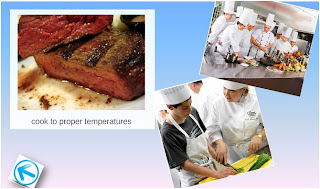Overview
Foodservice
operators have a plethora of choices when considering how they organize the
product flow. There are four systems presented. Foodservice operators use a
combination of these systems to manage labor, food cost, and food quality.
Goal
To
identify the foodservice systems and understand their usage.
Objective
qDefine food service types
qUnderstand the difference between these food service
types
qUnderstand the reason for preferring one over the others
Conventional
or Traditional
q Raw food products are purchased from supplier or
manufactures
q Raw foods
are held at appropriate temperatures until prepared and cooked for consumption
q Space is provided to hold raw foods
q Labour must have a culinary skill set
q Specialized cooking equipment is required
q Advanced training required in food safety
q Moderate food cost
Ready Prepared
ü Used when
cost of labor is high or lacking culinary skills
ü Food
items are purchase cooked and held frozen or chilled until heated
ü Cold
storage capacity is high
ü Small
requirements for diversity of cooking/heating equipment
ü Consistent
product quality
ü Moderate/high
food cost
Commissary
qCentral production of food items
qAppropriate for large network of distribution
qAdvance talent of culinary labor housed in a central
location
qCentralized control of quality
qCentralized location of physical culinary plant
qExpenditures are required for distribution of products
to the field
qLowest food cost
Sound of Food supply
we as consumers may
be excused for thinking it isn’t necessarily so. For example:
•“Mad
cow disease,” or bovine spongiform encephalopathy, has caused countries to ban
the importing of beef;
•Chronic
wasting disease, which afflicts deer and elk, has become a concern for hunters;
and
•E.
coli, Cyclospora, salmonella, and
hepatitis A have been found far more than we would like in restaurants and
supermarkets.
What is Safe Food?
The US
Food and Drug Administration (FDA) interprets “safe food” as food in
which
illness-causing substances (bacteria, chemicals, etc.), when they are
present,
are within acceptable levels.
Through
food research, the definition of “acceptable levels” is continually
changing –
for the better, it is hoped.
For
generations, people in “developed countries” have purchased their food from the
supply chain, which has lengthened with each generation.
As the
supply chain has lengthened, the risk of encountering food hazards – any
biological, chemical, or physical agent that is reasonably likely to cause
illness or injury in the absence of its control – has increased.
Preventing
the production & shipment of contaminated or adulterated food is heavily
favored over reliance on corrective action plans once contaminated goods have
entered distribution channels and subsequently the food supply.
Maintaining Safe Food Supply
1.Supplier pre-assessment / review
2.Food safety & sanitation
3.Preventive procedures
4.Documentation & Record Keeping
5.Supplier Documentation
(letters of guarantee,
certificates of analysis, etc.)
6.Auditing (internal / external)
7.Regulatory compliance
8.Food defence
9.Sanitation programs
10.Employee training
11.Environmental monitoring
12.Allergen
control
13.Foreign material control
14.Label control & packaging
15.Consumer complaints
The Flow of the Food




















No comments:
Post a Comment